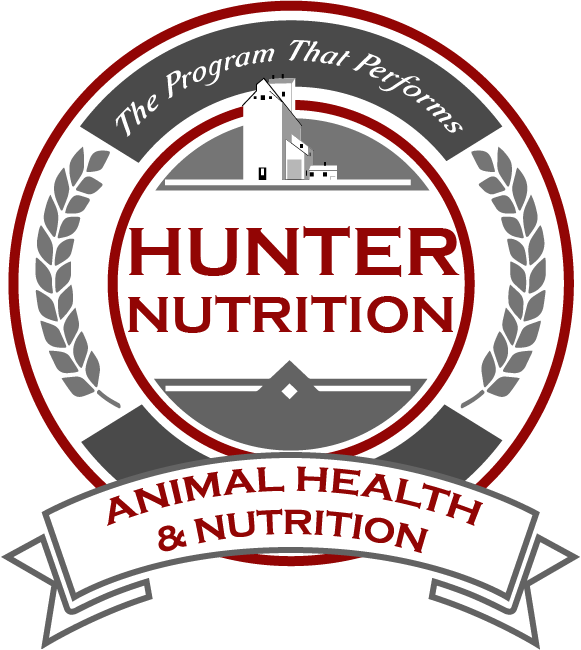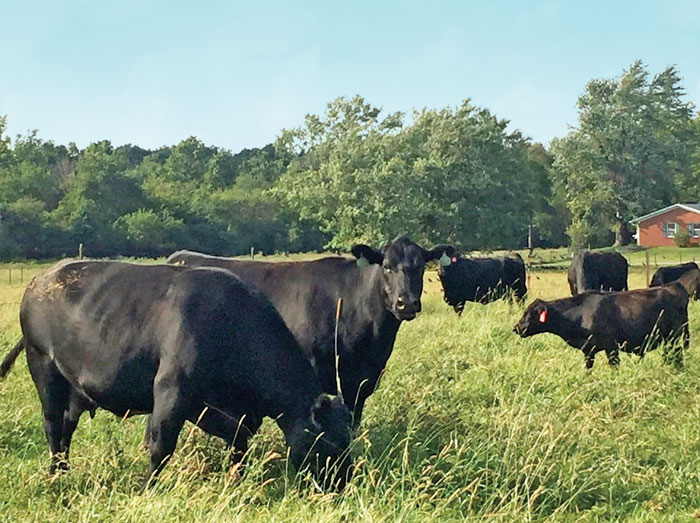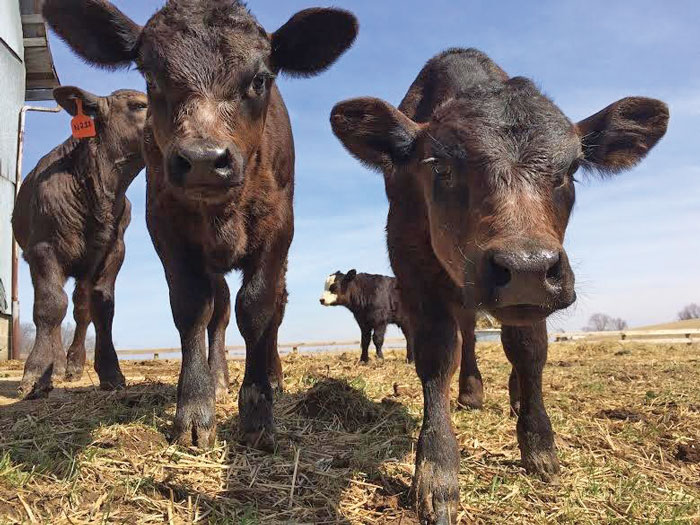
Spring is always a time of renewal and the hope of a good growing season. However the new season does create animal health and nutrition concerns. Concerns with performance (gain), grass tetany, fly season, and bloat should be addressed with preventative measures.
Don’t be fooled by the lush spring grass growth on your pastures. The early spring forage is mostly water and thus low in nutritional value. Animal performance suffers due to the inability to eat enough of the wet forage to meet dry matter, mineral, and energy needs. Providing free choice hay for at least two of days prior to turn out can prevent bloat. Continue feeding hay as a source of dry matter to maintain performance. Feeding a small amount of grain as a source of energy is also very helpful as a supplement to spring pasture.
The fast growing, high moisture pasture and its diluted nutritional value can cause grass tetany. This magnesium deficiency causes neurological problems; ‘grass staggers’, convulsions, and possibly death. Magnesium is needed for many physiological functions. Magnesium is a component of bone, important to nervous system function, and needed for enzyme function. Providing magnesium through the feed and/or with free choice mineral is very important. Animals need to be on adequate magnesium for a few weeks prior to spring grazing. We manufacture a High Magnesium 2:1 Beef Mineral for cow herds to address tetany in cattle.
Spring is also the time to begin your fly control program. You should use at least two of the three control methods. Control files with oral larvicides, residual premise spray, and/or fly ‘catchers’. When using an oral larvicide such as Rabon or Altosid, an early start is critical to success. Oral larvicides go ‘through’ the animal into its manure, when fly eggs hatch in this manure, the larvae are killed by the larvicide. Start animals on the oral larvicide four weeks prior to fly season. We manufacture a 2:1 Beef Mineral with Altosid that will supply your animals with this oral larvicide.
A good nutrition program is just as important during maintenance as it is when livestock are in a productive state. Don’t let the turn out to pasture be a time of neglect and nutritional deficit. The spring move to maintenance should be a time of rebuilding and nutritional fulfillment – allowing stock to be ready to reach their full potential.
FEEDING FOR REPRODUCTIVE SUCCESS -As we head into winter, good preparation is everything. Assuming you have adequate forage supplies then our attention goes to nutrition and health concerns. In our part of the country, we will be out of grass and all of its benefits by December, most likely earlier. Without high quality grass, ruminant livestock become totally dependent upon the herdsman’s feeding skill. Nutritional supplementation of the winter forage supply becomes critical. We will be in a demanding winter environment and need to fulfill the demands of late gestation and lactation. Gone are the nice, simple days of summer, watching the cows graze and thrive without much effort on our part. Much of your winter forage (hay, silage) will likely be first cutting. Despite all of our efforts we are stuck with at least 50% of our forage being hay that we call (a) less than desirable quality (b) okay or (c) poor quality.

The annual reproduction of ruminants in winter and early spring in the Midwest can be demanding. Preventative health (vaccination programs), nutrition and stockmanship must be at a high level for successful winter and early spring production. A good vaccination program for cows will lead to success at parturition and during the early life of the calves.
Winter time nutrition is critical, as we are supplementing almost all of the needs of the cow due to the stage of production and the low quality of much of our forage.
Winter feeding for production is a double challenge of low nutritional quality of stored forages and feeding for the highest demanding production stages of late gestation and lactation. The fact that these production cycles coincide with low quality forage makes supplemental feeding critical for success. The probability of deficiencies of even a basic nutrient such as energy or protein and certainly selenium, magnesium, calcium, Vitamin E, etc. is high! Critical feeding starts 6-8 weeks prior to parturition and continues through lactation. Without adequate energy, newborns will be small and weak, and stillborns and abortions will be at a higher level.
Cows who are shorted on energy will lose weight, have low milk production, a shortened live span, and have a longer re-breeding interval. Protein will be needed to maximize milk production and for viability of newborns. Calcium, magnesium, and, to some extent, potassium play a big role in metabolic disorders which can be disastrous. The sudden onset of hypocalcaemia and hypomagnesia frequently seen in otherwise healthy animals are results of those deficiencies. Feeding these nutrients as a preventive measure is more successful than treatment options. Iodine is very important in reducing stillborns and preventing goiter. Low selenium and/or vitamin E results in white muscle disease in newborns, weakness, low birth weight & viability, stillborns, more dystocia, delayed breed back time, and lowered performance.
We can help you with programs that supplement important nutrients such as energy, protein, selenium, vitamin E, magnesium, iodine, etc. The feed business is really about the animal health business and we take that responsibility seriously. We are not just here to sell you feed; we want you to be successful and profitable. Good feeding programs in gestation and lactation can really make or break you.
CREEP FEEDING CALVESIt is important to get calves started on creep early. Exposure to creep feed has many benefits; rumen development, heavier weaning weights, and increased profits. A good calf creep is palatable, well-fortified, and has the correct energy and fiber balance.
Young calves will not eat very much creep, however early consumption of even a small amount of feed is important. This early consumption aids in rumen development and sets calves up to consume more feed and gain more weight later on in the creep feeding period. A good way to get calves started is to place the creep close to the areas where cows and calves congregate. You will also get an earlier start if the first feed is a very palatable texturized grain mix. Our product ‘Beef Calf Creep B – Texturized’ works well as the feed to attract calves to the creep. After the calves are well started on feed you should switch to 14% Calf Creep Pellet.
Pelleted Calf Creep Feeds should be a 5/32” pellet and free of fines. Avoid calf creep feeds which are a blend of several kinds of pellets. These products can separate and often have fines which can cause bloat and off feed times. When ‘the blended pellet’ product separates you also see a decline in calf performance due to the ingredient separation. You will want a single size pellet which has all of the ingredients in that pellet and is a pellet free of fines.
 BEEF COW WINTER FEEDING
BEEF COW WINTER FEEDING
When it comes to supplemental winter feeding of the cow herd ; price, quality, and simplicity are often the primary concerns of the producer. Many producers like to supplement the cows ration with a pellet. Some mills are catering to this business by blending processor produced soy hull and corn gluten pellets. These products are a blend of two very large pellets which are full of fines, lack nutritional balance and fortification, and suffer from ingredient separation which causes lowered performance and off feed times. The mills offering feeds like this have good intentions – they just lack our capabilities. We have the knowledge of the ingredients’ nutritional value and the pellet mills to make a well fortified , fairly priced, uniform, nutritionally balanced pellet that you can supplement with.

Our ‘Beef Cow Pellet’ is available bagged, in bulk bags, and in bulk – picked up or delivered. Soy Hull and Commodity Pellet’s are also available for feeding growing cattle and the cow herd. These are available straight or in a blend –bagged, bulk bags, and in bulk.
If you are mixing rations for the cow herd, we can help with forage sampling and ration balancing. Balancing rations prevents under and over feeding which affects cost and performance. No matter your forage- (silage, hay, crop residue), it is important to know its nutritional levels so that the herd’s feed can be properly supplemented. Correctly balanced rations improve calf birth weight and vigor , eliminate deficiencies, address metabolic disorders, maintain cow body condition, increase cow longevity, and improve health.
VACCINATION PROGRAMSA cost effective, comprehensive ‘year around’ herd health program need not be complicated or expensive. Vaccinate for the common and basic problems that nearly all herds have such as IBR and BVD. Each herd should vaccinate for the basics plus any additional problems which are specific to their situation. For example; a herd which has a big problem with PI3 would vaccinate for IBR, BVD, and PI3. Whereas another herd might be giving clostridia and lepto vaccines.
 VACCINES: TOXOID VS. ANTITOXIN
VACCINES: TOXOID VS. ANTITOXIN
A toxoid is the common form of a vaccine which is given for long term immunity to disease. The toxoid form of a vaccine takes about two weeks to be effective, needs an annual booster, and gives long lasting immunity. By contrast an Antitoxin gives immediate immunity; but that immunity is short lived. TAT- tetanus antitoxin is a good example of this.
TAT is given right after injury or castration so calves are immediately protected against getting tetanus. In summary : Anti-toxins are used to treat a disease; and toxoid’s are used to prevent a disease.
HOW VACCINES WORKWhen a vaccine is given to an animal its system creates anti-bodies. The antibodies are specific to the particular disease’s) which the animal was vaccinated for. Toxoid vaccines take 7 to 14 days for antibody development to occur and thus give the animal immunity. Anti-toxin’s give immediate protection as a result of their direct neutralization of the toxin created by the infecting organism.
VACCINATING COWSCows should be vaccinated with an abortion control vaccine, such as StayBred VL5, prior to breeding, to control leptospirosis and vibriosis. Five weeks prior to calving, the cows should receive Scourguard 4KC and One Shot Ultra to protect newborn calves against scours and clostridia. A good cow vaccination program improves colostrum, which contains antibodies newborn calves require to protect them against many diseases.
VACCINATING CALVESWe recommend calves receive Inforce 3 twice, once at birth and again at 8 weeks of age to control respiratory diseases. At 4 months of age the calves should receive PI/BVD vaccine, also know as Bovishield GOLD 5, and One Shot Ultra to control clostridia. One Shot Ultra targets M haemolytica, the number 1 calf killer. When used in conjunction with BoviShield GOLD 5, calves are protected against both viral and M. haemolytica bacterial infections that lead to pneumonia.
Go Back to Articles